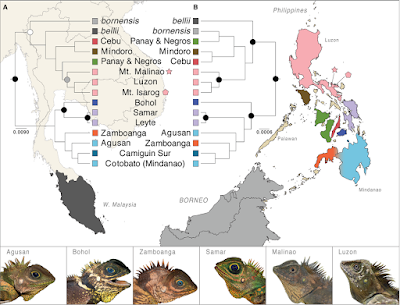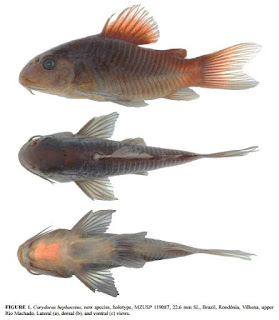[Most Recent Entries] [Calendar View]
Saturday, October 1st, 2016
| Time | Event | ||
| 3:40a | [Herpetology • 2016] Archipelago-wide Survey of Philippine Forest Dragons (Agamidae: Gonocephalus): Multilocus Phylogeny uncovers Unprecedented Levels of Genetic Diversity in A Biodiversity Hotspot Abstract We utilize robust geographical genetic sampling, and phylogenetic analysis of a new multilocus dataset to provide the first inference of relationships among Philippine Gonocephalus, combined with estimates of putative species diversity, in this almost unknown island radiation. Our results reveal startling levels of undocumented diversity, genetically partitioned at a number of geographical levels across the archipelago. We present the first survey of genetic lineage diversity, coupled with an archipelago-wide clarification of geographical structure in a unique archipelago-endemic radiation. Philippine Gonocephalus have previously escaped the attention of biogeographers as a result of the taxonomic confusion associated with low numbers of preserved specimens in museum collections. With new vouchered material and genetic sampling from a comprehensive, archipelago-wide vertebrate biodiversity inventory, our findings join many recent studies in highlighting the unprecedented faunal diversity in one of the world's most unique biodiversity conservation hotspots. Keywords: biogeography; diversification; Islands; lizard; reptile Luke J. Welton, Cameron D. Siler, L. L. Grismer, Arvin C. Diesmos, Jack W. Sites and Rafe M. Brown. 2016. Archipelago-wide Survey of Philippine Forest Dragons (Agamidae: Gonocephalus): Multilocus Phylogeny uncovers Unprecedented Levels of Genetic Diversity in A Biodiversity Hotspot. Biological Journal of the Linnean Society. DOI: 10.1111/bij.12878 | ||
| 4:09a | [Ichthyology • 2016] Corydoras hephaestus • Wrapped in Flames: A New Remarkably Colored Species (Teleostei: Callichthyidae) from the Rio Madeira basin, Rondônia State, Brazil
Abstract A new species of Corydoras is described from the upper Rio Machado, Rio Madeira basin, Rondônia State, Brazil. The new species can be distinguished from its congeners by the absence of contact between the posterior process of the parieto-supraoccipital and the nuchal plate; a ventral laminar expansion of the infraorbital 1 conspicuously developed; and the posterior margin of the pectoral-fin spine with serrations along almost of its entire length, only lacking in the distal portion. Additionally, Corydoras hephaestus possesses dorsal and pectoral spines short, and exhibits an unusual color pattern in life. The conservation status of the new species and other endemic species are briefly commented. Keywords: Pisces, Amazon, Corydoradinae, Fish, Endemism, Conservation Etymology. The specific epithet hephaestus is from the Greek, Ἥφαιστος (or Hēphaistos), the Greek god of fire, metalworking, forges, and blacksmiths. Alluding to the red color of the body and fins. A noun in apposition. Ohara, Willian M., Luiz F. C. Tencatt & Marcelo R. Britto. 2016. Wrapped in Flames: Corydoras hephaestus, A New Remarkably Colored Species from the Rio Madeira basin (Teleostei: Callichthyidae). Zootaxa. 4170(3): 539–552. DOI: 10.11646/zootaxa.4170.3.7 |
| << Previous Day |
2016/10/01 [Calendar] |
Next Day >> |





